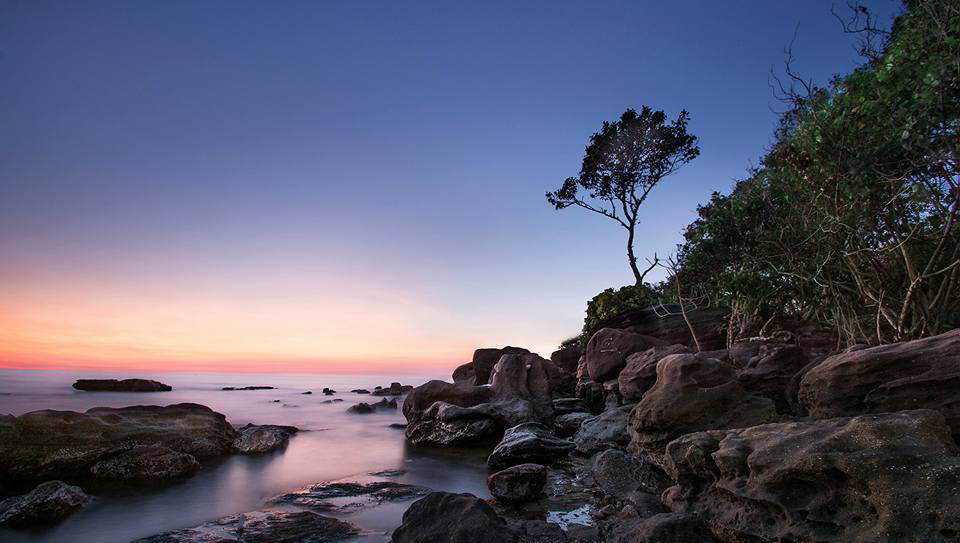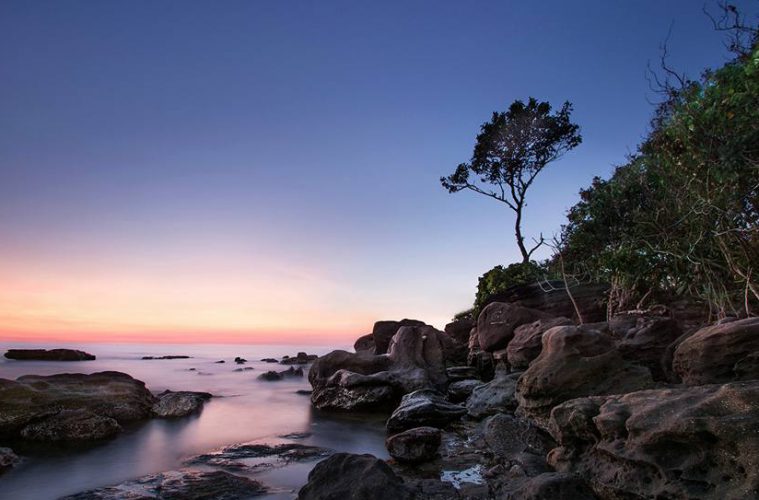BY JONATHAN BAR-ON
(No.7, Vol.6, Sep-Oct 2016 Vietnam Heritage Magazine)

Sunset on Phu Quoc Island, 2016
Photo: Nguyen Thai Khanh
The driver got out of the car to inspect the snake we had just run over. He poked it with a stick to be sure it was dead, and then put it in a plastic bag at my feet. ‘It will make a nice addition to lunch,’ he said. I wondered what the rest of the menu included.
We were driving over the mountains of Phu Quoc Island off the south western coast of Vietnam. Fifty percent of the island is covered by mountains and virgin forest. The island is ripe for development, with resorts springing up quickly near the towns. But this is the place to come for unspoiled mountain views, empty beaches and life with no deadlines. We wanted to avoid the tourist traps and littered beaches near the towns and see the island on our own terms with one of the local teachers as guide.
Most of the northern island has been declared a national park. Our driver stopped near the entrance and bought a bag of baby clams cooked in their shells. We sat on a rock in the middle of a stream and enjoyed our snack. It was October, the temperature was perfect, and we had the forest almost to ourselves.
Later, some friends met us with motorbikes and took us down a long forest trail with small houses secluded among the trees. Time slowed as we rode through an older and simpler world. Coming out at the bottom onto a clean white beach, we ate at one of the open-air restaurants that only the locals know. A fisherman with his nets and coracle smiled and invited me to take some photos. Vietnamese people love fresh seafood and beer, and we spent a couple of hours indulging in both. I was the only foreigner there.

A forest in the back of Ho Quoc Pagoda, Phu Quoc Island, 2016
Photo: Nguyen Thai Khanh

Monkeys at the Fairy Well, a tourist spot, on Phu Quoc Island, 2015
Photo: Trieu Vinh
Two marks of man on the island we felt we should visit. The first was the prison where the French, and later the Americans and South Vietnamese, held prisoners during the wars. The reconstructed tin sheds are full of life-size mannequins showing how prisoners lived. Sadly, the prison was known for its brutal tortures, and the life-like figures of caged men in the hot sun were reminders that man himself is sometimes the snake in the Garden of Eden.


At the Phu Quoc Prison. Photos: Le Thanh Binh
If the prison was depressing, the second site was inspiring. We drove between the mountains and the sea and stopped at the gate to Ho Quoc Pagoda, the Buddhist temple perched high on a hill. We climbed the long stairs between writhing dragons frozen in stone. The mountains behind the temple seemed eternal, but the pristine beach and open sea below looked newly created, as if yet untouched by man. Two monks set out incense and disappeared. My friend offered incense and prayers, handed me some incense sticks and went outside. I was alone in the temple. The sound of a muted gong added a touch of mystery to the serenity.
The next day we drove along the coast, enjoying the quiet sea and beaches framed by palm trees. We stopped at one of the pearl farms near Duong Dong, the district seat. A guide explained the process of ‘farming’ cultured pearls and the long showroom was filled with cases of pearl jewellery of all varieties and prices.
Our next stop was the Son Phat winery. We walked among the rose myrtle bushes, and then tasted the slightly sweet wine made from their fruit. It reminded me of black currant wine, but lighter in taste and colour with a nice bouquet. At about five dollars a bottle, I bought some as parting gifts and some to take home. When I declared the wine at the airport, it was sealed and allowed on the plane.
It was a weekend well spent, and I was back in Ho Chi Minh City by Sunday night. For those with more time to spend, there are adventures on and under the water as well. The best times to go are in April-May or September-October. Flights to and from Ho Chi Minh City last about fifty-five minutes and cost around $70 per person each way. Or, visit Rach Gia on the mainland coast and take a ferry from there (you will pay a little extra for a seat on deck).
You can book a double room at one of the small hotels for $15 to $30 a night and avoid the expensive same-sameness of the resorts on Long Street. We were privileged to be with friends who live on the island, but you can have the same friendly personal service with Jerry and his guides at Jerry’s Jungle Tours. Book early for an off-the-trail, on-the-water, or under-the-water custom adventure. Plan to go soon.

Ho Quoc Pagoda, Phu Quoc Island, 2016. Photo: Nguyen Thai Khanh

